Phosphorylated and aggregated TDP-43 with seeding properties are induced upon mutant Huntingtin (mHtt) polyglutamine expression in human cellular models
- PMID: 30863908
- PMCID: PMC11105362
- DOI: 10.1007/s00018-019-03059-8
Phosphorylated and aggregated TDP-43 with seeding properties are induced upon mutant Huntingtin (mHtt) polyglutamine expression in human cellular models
Abstract
The Tar DNA-Binding Protein 43 (TDP-43) and its phosphorylated isoform (pTDP-43) are the major components associated with ubiquitin positive/Tau-negative inclusions found in neurons and glial cells of patients suffering of amyotrophic lateral sclerosis (ALS) or frontotemporal lobar degeneration-TDP-43 (FTLD-TDP). Many studies have revealed that TDP-43 is also in the protein inclusions associated with neurodegenerative conditions other than ALS and FTLD-TDP, thus suggesting that this protein may be involved in the pathogenesis of a variety of neurological disorders. In brains of Huntington-affected patients, pTDP-43 aggregates were shown to co-localize with mutant Huntingtin (mHtt) inclusions. Here, we show that expression of mHtt carrying 80-97 polyglutamines repeats in human cell cultures induces the aggregation and the phosphorylation of endogenous TDP-43, whereas non-pathological Htt with 25 polyglutamines repeats has no effect. Mutant Htt aggregation precedes accumulation of pTDP-43 and pTDP-43 co-localizes with mHtt inclusions reminding what it was previously described in brains of Huntington-affected patients. Detergent-insoluble fractions from cells expressing mHtt and containing mHtt-pTDP-43 co-aggregates can function as seeds for further TDP-43 aggregation in human cell culture. The human cellular prion protein PrPC was previously identified as a negative modulator of mHtt aggregation; here, we show that PrPC-mediated reduction of mHtt aggregation is tightly correlated with a decrease of TDP-43 aggregation and phosphorylation, thus confirming the close relationships between TDP-43 and mHtt.
Keywords: ALS; Huntingtin; Huntington; Phosphorylation; Prion; Seeds; TDP-43.
Conflict of interest statement
The authors declare that they have no competing interests.
Figures
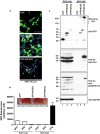
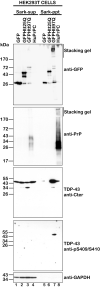



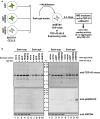
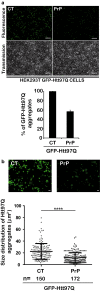
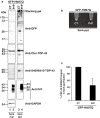
Similar articles
-
Antibody against TDP-43 phosphorylated at serine 375 suggests conformational differences of TDP-43 aggregates among FTLD-TDP subtypes.Acta Neuropathol. 2020 Nov;140(5):645-658. doi: 10.1007/s00401-020-02207-w. Epub 2020 Aug 10. Acta Neuropathol. 2020. PMID: 32778941 Free PMC article.
-
The phosphatase calcineurin regulates pathological TDP-43 phosphorylation.Acta Neuropathol. 2016 Oct;132(4):545-61. doi: 10.1007/s00401-016-1600-y. Epub 2016 Jul 29. Acta Neuropathol. 2016. PMID: 27473149 Free PMC article.
-
Phosphorylation of TAR DNA-binding Protein of 43 kDa (TDP-43) by Truncated Casein Kinase 1δ Triggers Mislocalization and Accumulation of TDP-43.J Biol Chem. 2016 Mar 11;291(11):5473-5483. doi: 10.1074/jbc.M115.695379. Epub 2016 Jan 14. J Biol Chem. 2016. PMID: 26769969 Free PMC article.
-
Phosphorylated and cleaved TDP-43 in ALS, FTLD and other neurodegenerative disorders and in cellular models of TDP-43 proteinopathy.Neuropathology. 2010 Apr;30(2):170-81. doi: 10.1111/j.1440-1789.2009.01089.x. Epub 2010 Jan 19. Neuropathology. 2010. PMID: 20102522 Review.
-
[Neurodegenerative disorders and TDP-43].Brain Nerve. 2009 Feb;61(2):161-6. Brain Nerve. 2009. PMID: 19235466 Review. Japanese.
Cited by
-
Huntington disease: Advances in the understanding of its mechanisms.Clin Park Relat Disord. 2020 May 6;3:100056. doi: 10.1016/j.prdoa.2020.100056. eCollection 2020. Clin Park Relat Disord. 2020. PMID: 34316639 Free PMC article. Review.
-
Analysis of HTT CAG repeat expansion in Italian patients with amyotrophic lateral sclerosis.Ann Clin Transl Neurol. 2022 Nov;9(11):1820-1825. doi: 10.1002/acn3.51673. Epub 2022 Oct 25. Ann Clin Transl Neurol. 2022. PMID: 36285345 Free PMC article.
-
Hunting for the cause: Evidence for prion-like mechanisms in Huntington's disease.Front Neurosci. 2022 Aug 24;16:946822. doi: 10.3389/fnins.2022.946822. eCollection 2022. Front Neurosci. 2022. PMID: 36090278 Free PMC article. Review.
-
The Role of TDP-43 in Neurodegenerative Disease.Mol Neurobiol. 2022 Jul;59(7):4223-4241. doi: 10.1007/s12035-022-02847-x. Epub 2022 May 2. Mol Neurobiol. 2022. PMID: 35499795 Review.
-
Co-Aggregation of TDP-43 with Other Pathogenic Proteins and Their Co-Pathologies in Neurodegenerative Diseases.Int J Mol Sci. 2024 Nov 18;25(22):12380. doi: 10.3390/ijms252212380. Int J Mol Sci. 2024. PMID: 39596445 Free PMC article. Review.
References
MeSH terms
Substances
Grants and funding
LinkOut - more resources
Full Text Sources
Other Literature Sources
Medical
Research Materials
Miscellaneous

